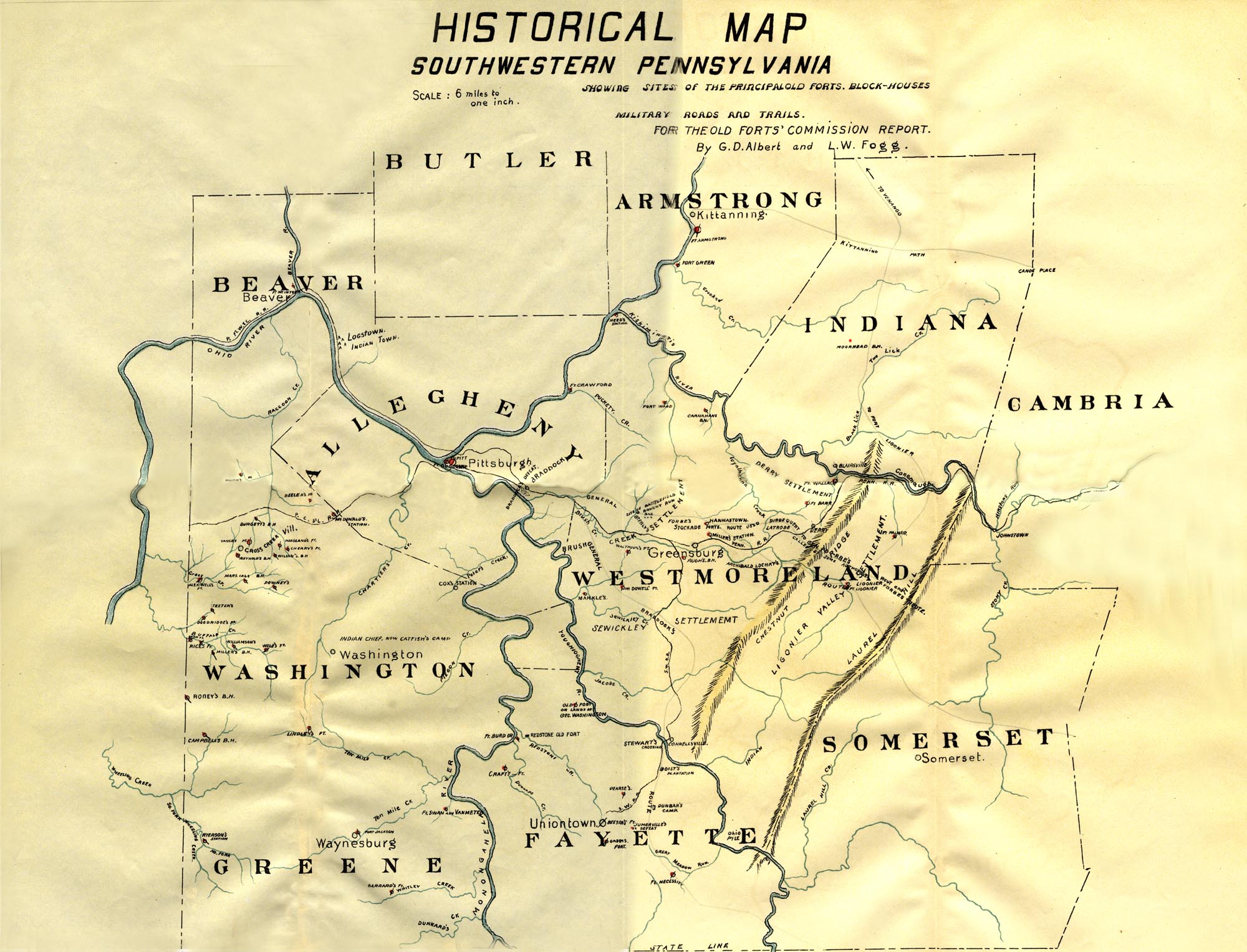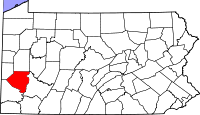


The Battle of Kittanning Point played a crucial role in shaping the future of the United States.

Let's set the stage. Britain, France and Spain have all established colonies in America, and are vying for the lucrative resources and expansion of land that remains. France was established in Canada, Spain established in Florida, and Britain established in the land in between, but only that land east of the Appalachian Mountains. West of the Appalachians was Indian land. However, the great American land grab saw various colonies claiming rights to the Indian land. Virginia and North Carolina both claimed land due west of their present state boundaries. Although the Penn family had legitimately bought millions of acres from the Indians, none of this land was west of the Applachians. Pennsylvania settlers and other American land speculators eagerly eyed the land available there. France had explored this territory with their Canadian fur traders, set up some forts like Fort Duquesne, and hoped to bottle Britain in to only the part of America east of the Appalachians.
At this time, there was no war in Europe. The 1748 Treaty of Aix-la-Chapelle seemed to have ended the Anglo-French struggle for colonial supremecy. Both nations were exhausted and both George II and Louis XV were weary of the high costs of war. However, the greed of the commercial upper classes on both sides would not let the matter rest. When the French moved to rearm, the British did likewise. In the Spring of 1752, the French had begun to make attempts to link their vast possessions along the St. Lawrence River in Canada with those to the south, in what would become known as Louisiana, by entering the disputed valley of the Ohio.
Robert Dinwoodie, the British Governor of Virginia, sounded the alarm to London. He had a personal stake in the matter as he was a member of the Ohio Company - formed in 1747 by leading Virginians including Lawrence Washington, the landed half-brother of George Washington - to speculate in land and exploit the Ohio Valley. At the age of 21, Major George Washington volunteered to deliver the message from Dinwoodie to the French, that the French were to leave the Ohio Valley. At Fort Le Boeuf, the French officer in charge, Legardeur de St. Pierre, politely refused stating that the country belonged to the French, that no Englishman had the right to trade in the Ohio Valley, and that he had orders to imprison any who attempted it. Washington delivered the message back to Dinwoodie in January, 1754.
Neither Britain nor France was ready to formally declare war - that would wait for another year and a half when the Seven Years War started, involving most of Europe. However, both saw that the key to the Ohio Valley were the Indians, who had been pushed there by the settlers on the east side of the Appalachians. The early advantage was with the French who already had Fort Duquesne and the alliance of most of the western Indians. A congress convened in Albany, naming an Indian agent named William Johnson to meet with the Five Nations at Onondaga and try to persuade them to remain loyal to the British. Their prescient response was "the Governor of Virginia and the Governor of Canada are quarreling over lands that belong to us, and their quarrel may end in our destruction". They had contempt for the British because the French had prepared for war, but even Albany, on the French frontier, had not been fortified. The alliance the British wanted did not happen.

Washington and Dinwoodie both identified the future site of Pittsburg as the key location to control, due to it being where the Allegheny and Monongahela Rivers formed the Ohio River. In trying to garrison a new fort in that area, the now 22 year old Lieutenant Colonel Washington skirmished with a French and Indian party that had just destroyed the new fort, and the French and Indian War was now launched.
In 1755, France prepared to send a fleet carrying 3,000 soldiers to the new world. Britain countered by sending Major General Edward Braddock to Virginia with 2 regiments to take command of all regular and colonial forces in America. Washington volunteered to serve on his staff. Braddock, openly contempuous of the colonial troops, but having a disfunctional staff himself, led his men into a major battle where he refused to let his men fire from behind cover in the forest. The result was disastrous. Of 86 officers, 63 were killed or wounded. Washington had 4 bullet holes in his clothes and 2 horses were shot out from under him. Braddock himself took a fatal shot in a lung. The British turned and ran. The next day, before he died, Braddock cursed his redcoats, while praising his officers and "the blues" of Virginia. The West was now unprotected.
Beginning about October, 1755, the Delawares and Shawnees, who had been sitting out waiting to see which side would win (not wanting to be on the losing side), began raiding the Pennsylvania settlements, often with French cooperation . Native American warriors generally made no distinction between combatants and noncombatants: women and children were routinely killed and scalped, and prisoners were sometimes tortured to death. Notable among the Indian raiders were the Delaware war leaders Shingas and Captain Jacobs, who both lived at Kittanning. The colonial governments of both Pennsylvania and Virginia offered rewards for their scalps.
The British pioneers desire was to settle land. Each settler tried to defend his own farm rather than forming themselves into a militia protecting a central community. Pennsylvania was the land of many horrifying tales of carnage, for these borderers lived closest to Fort Duquesne. Governor Morris of Pennsylvania petitioned for help, but the anti-war Quakers ruled Pennsylvania from their comfortable sanctuary in Philadelphia, and thought it was a sin to fight the noble savage. Slaughter mounted on slaughter while the different sides squabbled in Philadelphia. Finally, Thomas and Richard Penn sent £5,000 to be used in the defense of the colony. This was the beginning of the end of Quaker rule in Pennsylvania.

After a combined force of French and Delaware Indians, led by Captain Jacobs, destroyed Fort Granville in June 1756, taking a number of prisoners back to their fortified village of Kittanning on the Allegheny River, Governor John Penn ordered provencial troops stationed in Cumberland County to respond. Lieutenant Colonel John Armstrong, whose brother Edward had been the Lieutenant in charge and had been killed at Fort Granville, led 300 militiamen on a long march to the village. There they launched a surprise attack on 8 September 1756. After a 6 hour battle, the village was destroyed, Captain Jacobs was killed, and the Pennsylvanians made a hasty retreat.
Historians have argued as to the significance of this battle. On one hand, Armstrong suffered more casualties than he inflicted, most of the villagers escaped, and he only recovered 11 of the 100 captives. On the other hand, the raid shocked the Indians and revealed their vulnerability, showed the French and Indians that the future was not just one sided raids against the British, and finally gave the settlers hope that they would prevail in the end. Soon, a peace faction led by Shingas's brother Tamaqua, came forward. Tamaqua eventually made peace with Pennsylvania in the Treaty of Easton, which enabled the British, under General John Forbes, to successfully mount an expedition to drive the French away from Fort Duquesne. More Pennsylvania history can be found on this linked page.
Included in Lieutenant Colonel Armstrong's force of 300 at Kittanning was James Carruthers, born in 1739 in County Tyrone, Ireland and twin brother of Andrew Carruthers, Captain at the Battle of King's Mountain.
Lieutenant Colonel John Armstrong had also been born in Ireland - in 1717. He came to Pennsylvania as a surveyor for the Penn family. In 1750, he laid out the first plat or plan for the town of Carlisle, Pennsylvania and was one of its first settlers. He later was appointed surveyor for the newly established Cumberland County.
John Carruthers, 1739-1798, County Lieutenant for Cumberland County during the Revolutionary War and member of the Pennsylvania General Assembly in the 1780's, was also born in Ireland. In about 1765, he married Mary Armstrong, daughter of James Montgomery Armstrong, who had a large grant of land in Cumberland County from William Penn. At this time, no genealogical link has been found between Mary Armstrong and John Armstrong, the "Hero of Kittanning".
John Carruthers, 1739-1798, had a grandson, James Carothers who married Sarah Forsythe. Sarah was the granddaughter of Benjamin Kuykendall, who fought with Braddock and Washington in 1755. Both John Carothers and Benjamin Kuykendall are the great-great-great-great-grandfathers of the author of this page, Craig H. Carothers.
Family Name Christmas GiftsClick on the item below for merchandise with the family name or crest
Related Names To request another name - email webmaster@carothers-carruthers.com |
||
Search This Site by Keyword |
||
** Records of the Carruthers Family **The book Records of the Carruthers Family is now available in serialized .pdf form from this web site. New sections will be added monthly. Click on the above link to go to the page with the sections. |
||
|
|
||
|
Genealogists |
||
|
|
||
|
||||||||||
|
|
||
Sponsored Links |
||
Site Map - Click "+" to see all pages |
||
webmaster@carothers-carruthers.com


